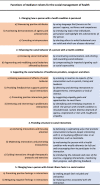Assistive Robots for the Social Management of Health: A Framework for Robot Design and Human-Robot Interaction Research
- PMID: 32421077
- PMCID: PMC7223628
- DOI: 10.1007/s12369-020-00634-z
Assistive Robots for the Social Management of Health: A Framework for Robot Design and Human-Robot Interaction Research
Abstract
There is a close connection between health and the quality of one's social life. Strong social bonds are essential for health and wellbeing, but often health conditions can detrimentally affect a person's ability to interact with others. This can become a vicious cycle resulting in further decline in health. For this reason, the social management of health is an important aspect of healthcare. We propose that socially assistive robots (SARs) could help people with health conditions maintain positive social lives by supporting them in social interactions. This paper makes three contributions, as detailed below. We develop a framework of social mediation functions that robots could perform, motivated by the special social needs that people with health conditions have. In this framework we identify five types of functions that SARs could perform: (a) changing how the person is perceived, (b) enhancing the social behavior of the person, (c) modifying the social behavior of others, (d) providing structure for interactions, and (e) changing how the person feels. We thematically organize and review the existing literature on robots supporting human-human interactions, in both clinical and non-clinical settings, and explain how the findings and design ideas from these studies can be applied to the functions identified in the framework. Finally, we point out and discuss challenges in designing SARs for supporting social interactions, and highlight opportunities for future robot design and HRI research on the mediator role of robots.
Keywords: Health management; Human robot interaction; Socially assistive robots.
© Springer Nature B.V. 2020.
Conflict of interest statement
Conflict of interestThe authors declare that they have no conflict of interest.
Figures
References
-
- Cohen S. Social relationships and health. Am Psychol. 2004;59(8):676. - PubMed
-
- de Jong-Gierveld J, van Tilburg TG, Dykstra PA et al (2006) Loneliness and social isolation. Cambridge handbook of personal relationships. pp 485–500
-
- Tickle-Degnen L, Scheutz M, Arkin RC (2014) Collaborative robots in rehabilitation for social self-management of health
LinkOut - more resources
Full Text Sources


